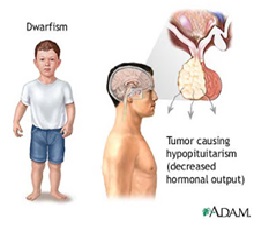“I was told I would never make it because I’m too short. Well, I’m still too short. It doesn’t matter what your height is, it’s what’s in your heart.”
- Kirby Puckett
This
quotation by Kirby Puckett really inspires me and it comes across my mind
whenever I hear comments about my height. Actually, when I was assigned to write
about growth hormone, I got excited as I’m pretty interested about this topic
because of my height. Being 4 feet, 11 inches tall, it seems like everyone is
taller than me. And even though I’m already 19 years old, I still get called
“kiddo” by others. I admit… I hate being short, but now I’m used to it though
I’ll still jump high upon New Year’s Eve countdown (even if to no avail, haha!).
Before,
I always think that life is so unfair. Why are we not created equally, in terms
of height? As they say, everything has a reason, ok? So where can we blame our
height? Well, maybe we can blame it to the growth hormone… Here’s why…

Growth hormone (GH), secreted and
stored by the somatotrophs in the anterior pituitary gland, is a 191 amino acid
polypeptide hormone having two disulphide bonds. Also called somatotropin,
growth hormone is an important hormone that stimulates the growth and
development in humans. GH stimulates the liver and other tissues to produce
insulin-like growth factor (IGF-1) which in turn stimulates the production of
cartilage cells, facilitating bone and muscle growth. This hormone is
responsible on how much growth one will have, depending on the level of its
release in the body. It also participates in other complex physiologic
processes such as in protein, fat, and carbohydrate metabolism.
What regulate the synthesis and
secretion of GH? Two hypothalamic neuropeptides are responsible for this
action. These neuropeptides are the growth
hormone-releasing hormone (GHRH) and somatostatin
(SS). GNRH stimulates both the synthesis and secretion of growth hormone.
SS, in response to GNRH, inhibits the release of growth hormone and other
stimulatory factors. Ghrelin, a
peptide hormone secreted by the stomach, stimulates production of growth hormone
by binding to receptors of somatotrophs.
Too
Much is Bad
Acromegaly is the result of
overproduction of growth hormone that commonly presents during adulthood. The
condition causes diffuse overgrowth of extremities, soft tissues, and organs.
Other characteristic features of acromegaly include prognathism which is the
bulging out of the lower jaw (mandible); spade-like hands; and frontal bossing.
Acromegaly is caused by pituitary
adenoma, a benign (non-cancerous) tumor in the pituitary gland. Pituitary
adenoma raises GH level and also raises the level of IGF-1.
Can acromegaly be treated? Yes, it can
be. Treatment includes surgery to remove the pituitary tumor, intake of drugs
that block the action or lower the production of GH (i.e. octreotide, lanreotide, cabergoline,
pegvisomant),
and also radiation to destroy the tumor cells.
To further understand what acromegaly
is, a YouTube video about the condition is presented below. Acromegaly was
explained well by Dr. Frances Broyles of Swedish Medical Center.
Have you ever wondered how can one grow
so tall, as in so tall, even up to 9 feet? It is because of the condition gigantism.
Excessive
GH secretion that develops in adolescents or young children, that is before the
closure of epiphyses, results to gigantism.
The height of persons with gigantism falls between 7 feet (84 inches) and 9
feet (108 inches). Treatment is same with acromegaly.
To
date, Sultan Kosen is the tallest man living as according to The Guinness Book
of World Records. He measures 251 cm (8 ft, 3 in).
 |
| Chandra Bahadur Dangi |
Tests Used to
Diagnose GH Disorders
Here are some of the tests used to detect problems in GH
release:
o IGF-1 :
This
test is a blood test used to determine the levels of IGF-1. As I stated above,
IGF-1 is produced by GH, that means it can be used to determine the extent of
GH release.
o Oral
glucose tolerance test:
Maybe you are thinking
that OGTT is only used to diagnose instances of diabetes mellitus. Well, think
again. OGTT can also be used in the diagnosis of GH disorders. It is a GH
suppression test in which GH levels in the blood are measured after the intake
of glucose solution. The glucose solution will inhibit the pituitary gland from
producing GH. However, in patients with acromegaly, the GH level will not
change because the pituitary tumor that produces GH will not stop releasing GH.
o Insulin
Tolerance Test:
A GH stimulation test
regarded as the “gold standard” for measuring GHD. In this test, the pituitary
gland is stimulated to produce GH by causing hypoglycemia. Other GH stimulants
are arginine and clonidine.
o Computed
Tomography (CT)
and Magnetic Resonance Imaging (MRI)
Images from these
imaging tests may reveal a brain tumor which can be of help in the diagnosis of
GH disorders.
So, that’s it. These are just some of
the facts regarding growth hormone. I started this blog post with an inspiring
quotation and I also want to end it with another quotation:
“It’s
not the size of the dog in the fight, It’s the size of the fight in the dog.”
-
Mark Twain
*Thanks
for reading my blog! I hope you learned something. God bless J
Oh by the way, take a look at these funny meme comics.... hahaha!
References:
McPherson, R.A., Pincus, M.R. Henry’s Clinical Diagnosis
and Management by Laboratory Methods. 22nd Edition. 2011
Bishop, M.L., et al. Clinical
Chemistry: Techniques, Principles, Correlations. 6th ed. 2010
Rosenbloom AL, Connor
LE. Hypopituitarism and other disorders of the growth hormone-insulinlike
growth factor I axis. In: Lifshitz F (ed), Pediatric Endocrinology, 3rd ed,
New York, Informa Health Care 2007; 65-101.
Abrams RL, Parker ML,
Blanco S, Reichlin S, Daughaday WH. Hypothalamic regulation of growth
hormone secretion. Endocrinology 1966;78:605-613.
Photo credits:
https://en.wikipedia.org/wiki/File:Endocrine_growth_regulation.svg
|
http://www.netterimages.com/image/5748.htm
http://www.telegraph.co.uk/news/picturegalleries/howaboutthat/6988398/The-worlds-tallest-man-Sultan-Kosen-and-the-shortest-man-in-the-world-He-Pingping-meet.html
http://www.nwchc.com/body.cfm?xyzpdqabc=0&id=6&action=detail&AEArticleID=100146&AEProductID=Adam2004_1&AEProjectTypeIDURL=APT_3##
http://www.tumblr.com/tagged/shortness
Video Credits:
http://www.youtube.com/watch?v=AX48MPIDyYw






